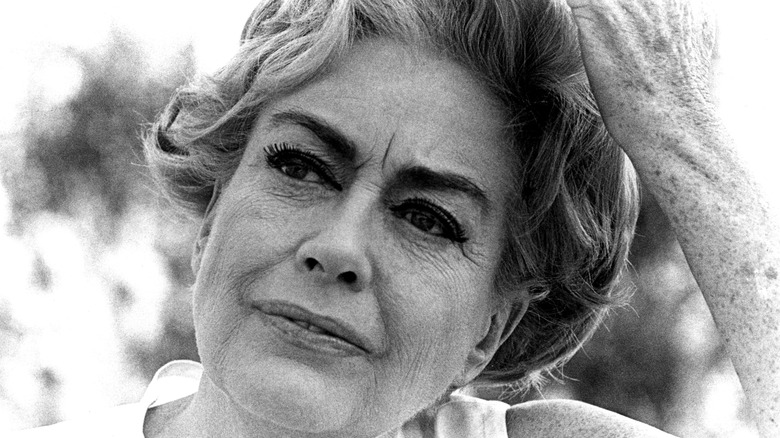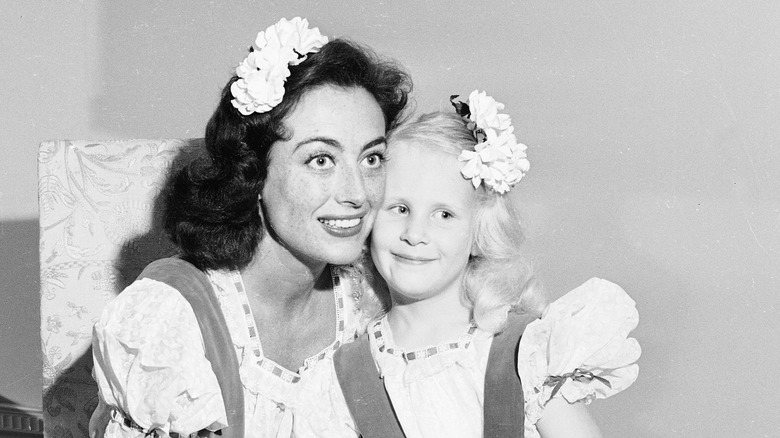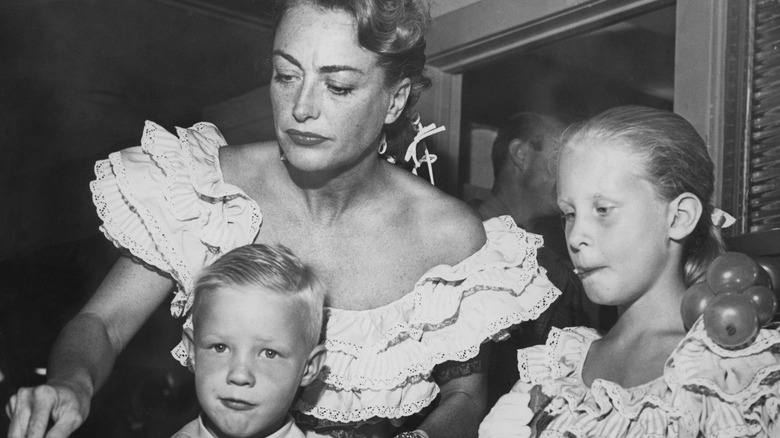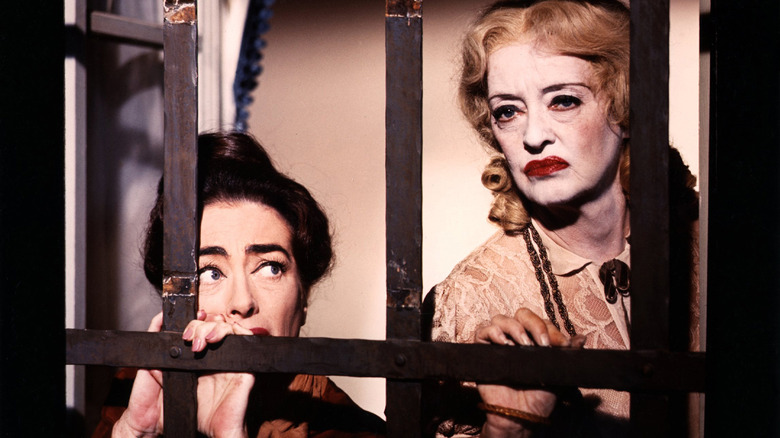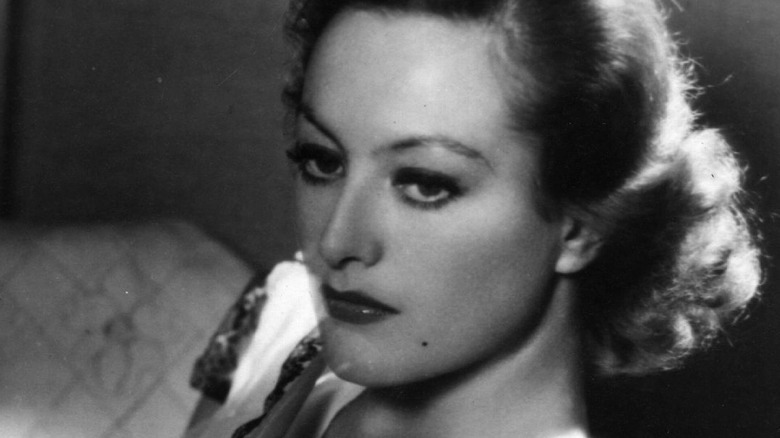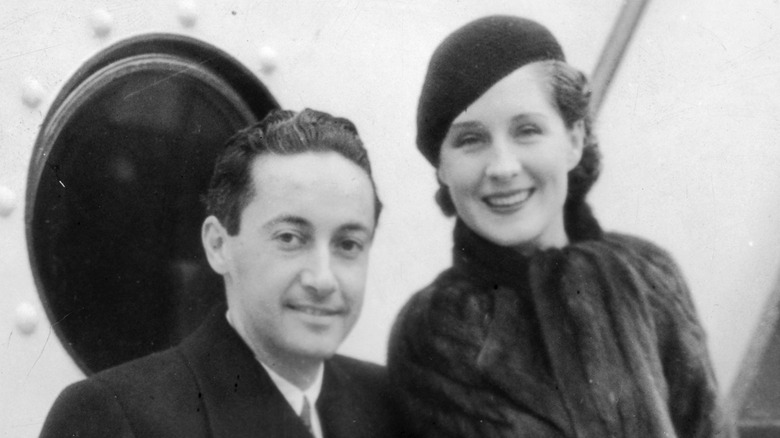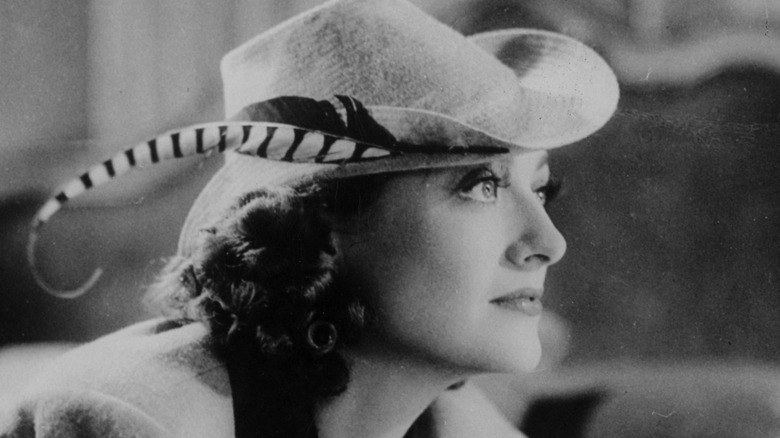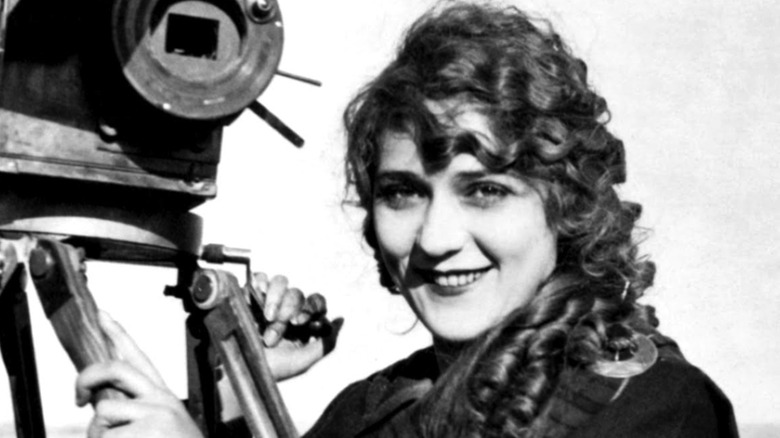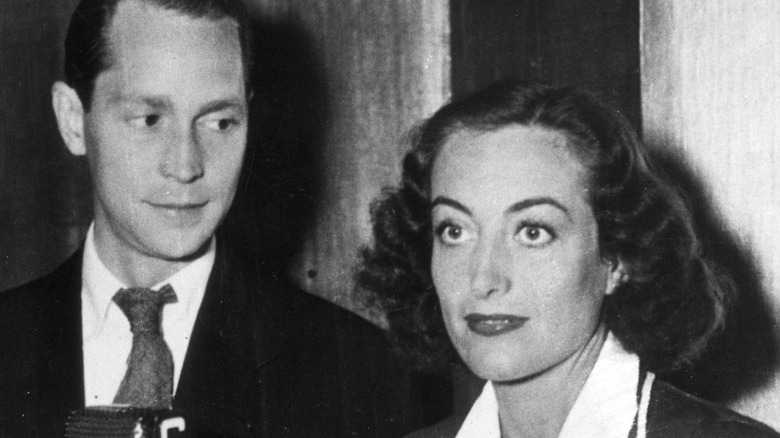The Messed Up Truth About Joan Crawford
Joan Crawford was a self-made Hollywood success story. She grew up poor in the South, and her dancing earned her a contract with Metro-Goldwyn Mayer. After struggling to reach her career goals in her early days at MGM, she changed her name and transformed herself into a 1920s flapper who obsessively practiced her speech to eliminate her southern accent, according to Bob Thomas' "Joan Crawford: A Biography."
Crawford's "rags-to-riches" spirit was captured in many of the roles she took on in the 1930s, but in 1938, she was labeled "box office poison" because her movies didn't always bring in a ton of money, per Biography. But by 1945, she was back with a vengeance, earning an Academy Award for "Mildred Pearce" and acting steadily until the 1970s.
Crawford's acting career may have floundered and faded had she not been as determined as she was. But according to reports from her co-stars and even her children, her ambition was tinged with bitterness. Here's what Crawford was reportedly like behind the curtain.
Joan Crawford's daughter described her as cruel and abusive
When Joan Crawford's adopted daughter, Christina, was 13 years old, Joan allegedly grew abusive toward her. "You never forget that," Christina told The Guardian in 2008. "It was up close and personal. She came this far from my face, and you could see it in her eyes, you can see if someone is trying to kill you."
In 1978, one year after Joan's death, Christina published the autobiography "Mommie Dearest," which depicted her mother in far-less-then flattering terms.
Upon the book's release, Joan's other daughter, Cathy, said that Christina "had her own reality ... I don't know where she got her ideas. Our Mommie was the best mother anyone ever had.," (per Vanity Fair). In response, Christina pointed to their eight-year age gap and the fact Cathy was not around to witness Joan's treatment of her, adding that Cathy may have been a more docile child. "What my mother wanted was fans and puppies, not human beings," she said. "She was as close to being a totally manufactured person as I've ever met," (per IMDb)
Joan Crawford also had a sour relationship with her son Christopher
Joan Crawford's adopted son Christopher has backed up Christina's claims of Joan's cruelty. By the age of 35, Christopher was scarred from an explosion in Vietnam, working as a lineman with Long Island Electric, and living on welfare. He gave a rare interview to the Los Angeles Times in 1978, referring to his mother only by her initials. "She was not a mother," he told the newspaper (via Joan Crawford Best). "She was not a family. I honestly to this day do not believe that she ever cared for me."
Christopher claimed that, when he was 7 years old, Joan caught him playing with matches and made him hold his hand in the fireplace as punishment. "I had blisters all over my hand," he recalled, "[and] that day I ran away for the first time." When he was ten, he ran away again and spent several days conning people for food money and sleeping under the Santa Monica Pier. Christopher also said that Joan kept him strapped into bed in a harness until he was 12 years old.
Christopher's final interaction with Joan was a plea for help for his infant daughter. "I called J.C. and said, 'I need your help. Your granddaughter needs blood and she needs it now. She might die,'" Christopher recalled. "J.C. said, 'She's not my granddaughter. You were adopted.' I lost my temper and slammed down the phone so hard I broke the receiver. That was it between J.C. and me."
Joan Crawford's feud with Bette Davis got ugly
Joan Crawford's feud with fellow actor Bette Davis is the stuff of legend. Their rivalry spanned multiple decades, involving jealous disputes over who was stealing the limelight. But the bitterness reached its peak during the 1962 race for the Best Actress Oscar.
"I always knew Bette would be chosen, and I hope and pray that she wins," Crawford told reporters after the nominations were announced. She had not been nominated, but Davis had, for their movie "What Ever Happened to Baby Jane?" (via Vanity Fair). "That's so much bull," Davis said after she heard Crawford's remark, as quoted in Shaun Considine's "Bette & Joan: The Divine Feud." "When Miss Crawford wasn't nominated, she immediately got herself booked on the Oscar show to present the best director award. Then she flew to New York and deliberately campaigned against me. She told people not to vote for me. She also called up the other nominees and told them she would accept their statue if they couldn't show up at the ceremonies."
When Ann Bancroft was announced as the winner, Crawford gleefully accepted the award on her behalf. "Moments later, Crawford floated down the hall past my door," Davis recalled. "I will never forget the look she gave me. It was triumphant. The look clearly said, 'You didn't win and I am elated!'"
She may have been abused by her stepfather
Even when Joan Crawford was born is a matter of contention. According to Biography, the day is settled (March 23), but the year could be anywhere between 1904 and 1908 (Crawford's preferred choice). Whenever she was born, she came into the world with the name Lucille LeSueur, to parents Thomas LeSueur and Anna Bell Johnson. Her father abandoned the family not long after Crawford's birth.
For security, Johnson arranged a marriage of convenience with Harry Cassin, owner of Lawton, Oklahoma's opera house. According to "Joan Crawford: The Essential Biography," Crawford first took a shine to show business while visiting her new stepfather's establishment. She and Cassin also grew close; he gave her the nickname Billie, and she went by his surname. It was a closer relationship than Cassin had with Johnson. Theirs was a loveless union, and Johnson was unhappy when Cassin became embroiled in an associate's scandal.
The marriage ultimately collapsed when Johnson learned the truth about Cassin and Crawford's connection: since Crawford was 11, they had been in a sexual relationship. It only ended when Johnson caught them in a compromising situation. She left Cassin and took her children with her to Kansas City. Crawford later claimed to have instigated things with her stepfather, insisted that he was "gentle," and felt her mother was jealous and resentful of her. Even late in life, when confronted with the reality that Harry Cassin was a child molester, she kept defending him.
She labeled Norma Shearer her nemesis
One of the most well-known pieces of the Joan Crawford story is her longstanding feud with Bette Davis, but the one-time First Lady of the American Screen was far from Crawford's only source of professional antagonism. While under contract to MGM, she nursed a rivalry with Norma Shearer. Crawford got her start in movies as Shearer's body double in 1925's "Lady of the Night" (per the San Francisco Silent Film Festival), but as her own star rose, she became increasingly resentful. Part of the animosity came from the fact that Shearer's husband was Irving Thalberg, the legendary head of production at MGM, who wasn't above nepotism. Shearer was often first in consideration for the choicest parts in the best films. "What chance do I have?" Crawford once complained. "[Norma] sleeps with the boss!"
Even after Thalberg's death, Shearer remained a favorite at MGM. So when casting opened up for "The Women" in 1939, according to "Joan Crawford: The Essential Biography," Crawford was delighted to take the part of the rough, unsympathetic Crystal Allen against Shearer's happy housewife. "If I can't have a good picture of my own," she said, "let me sneak into someone else's." "The Women" was more an ensemble than a vehicle for any one star, but that didn't matter for the rivalry. The film was a hit, and it remained a favorite of Crawford's. She had a good word to say about the efforts of everyone involved – except Shearer.
Joan Crawford wasn't her real name (and she hated it)
Like many a performer before and since, Joan Crawford was known to the public by a stage name. Per Britannica, she was born Lucille Fay LeSueur. After her mother's remarriage, she took the surname of her stepfather Harry Cassin, who also gave the child the nickname Billie according to "Joan Crawford: The Essential Biography." That was the name she began her career with when she was a dancer in Kansas City, Chicago, and eventually, Broadway.
The Broadway production "The Passing Show of 1924" was where MGM producer Harry Rapf first spotted the future Crawford, according to Biography. He was sufficiently impressed to offer her a contract, but he wasn't satisfied with her name. Her birth name wouldn't do either; according to Crawford's daughter Christina (via the Guardian), LeSueur sounded too much like "sewer." MGM decided to hold a contest, inviting filmgoers to submit names for their newest star. Besides giving an actress a stage name, the winner got $1,000.
When "Joan Crawford" won the contest, she ended up the only one unhappy with it. According to film critic Emanuel Levy, she wanted her first name pronounced "Jo-Anne" instead of Joan, and she thought Crawford sounded too much like "crawfish." But that was the name connected to her stardom, so she stuck with it.
She had a feud with Mary Pickford
On June 3, 1929, Joan Crawford took her first husband, Douglas Fairbanks Jr. They wed in New York after a two-year engagement according to the Los Angeles Times (via The Best of Everything). Husband and wife put the best possible face on for the paper, but their relationship struggled against a significant roadblock to reach the altar. Fairbanks was the son of superstar Douglas Fairbanks Sr. and the stepson of "America's Sweetheart" Mary Pickford. Neither was initially keen to have Crawford as a daughter-in-law, according to "Joan Crawford: Hollywood Martyr" and publicly denouncing their son's match. They refused to have the newlyweds at their Hollywood mansion, Pickfair.
Of the two parents, Pickford was the more hostile. Fairbanks Sr. gradually warmed to Crawford the more time she spent at Pickfair, according to "Joan Crawford: The Essential Biography." That may have contributed to Pickford's resentment, as did a sense of professional rivalry. The two never became close, and Pickford only showed Crawford some warmth after they had both divorced from the Fairbanks family. Crawford would use her one-time mother-in-law's iciness toward her as a frame of reference for several roles throughout her career.
As for Fairbanks, Crawford was only married to him until 1933. They didn't share much beyond physical attraction, and Fairbanks resented Crawford's focus on her career. Each had affairs before calling it quits, with Crawford's dalliance with Clarke Gable becoming the stuff of Hollywood legend (per the Hollywood Reporter).
Her second marriage was very strange
Joan Crawford was disinclined to marry again after things didn't work out with Douglas Fairbanks Jr. according to Bob Thomas's "Joan Crawford: A Biography." She was gradually won over by the charms and pleas of her fellow actor Franchot Tone. Sophisticated, well-to-do, and a classically trained stage actor, Tone was connected with Lee Strasberg and the Group Theater before coming to Hollywood, and rumors persist that he was sent out by Strasberg to help promote their work according to Tone's biographer Lisa Burke (per Alt Film Guide). He and Crawford appeared in seven films together during their four-year marriage.
The two actors soon ran into a conflict of working styles. Tone was a quick study on lines and preferred the theater's lengthy on-set rehearsal period, while Crawford rigorously studied her scripts in the evenings, when Tone wanted to hit the town. He was quick to credit his wife for helping him adjust to film production, and she was happy to get an education in classical culture from her husband.
Crawford was a much bigger star than Tone, however, and their professional differences began to affect their personal relationship. According to "Bette & Joan: The Divine Feud," a declining career drove Tone to drink, infidelity, and physical violence toward Crawford. Despite this, after their divorce Tone and Crawford remained close. They were friends for the rest of his life, per Thomas. In 1968, Crawford fulfilled his final wish and scattered his ashes near Muskoka Lake.
